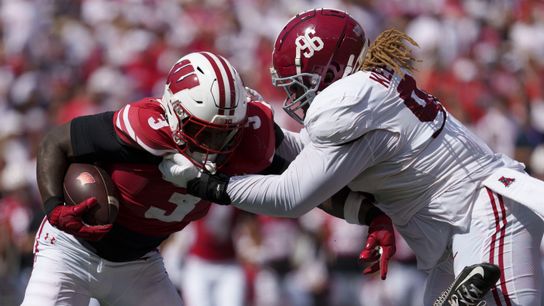Following their version of the Paris Peace Conference last week in Nashville, multiple outlets confirmed Tuesday that the Big Ten and SEC will pursue a scheduling agreement to begin at some point in the foreseeable future.
USA Today reported Tuesday that the two conferences could play anywhere between 12 annual games (if the SEC moves to nine conference games, to match the B1G) and 20 (if the B1G reduces down to eight conference games, to match the SEC).
The SEC has no conference schedules set beyond the 2025 season, which is also when the current 12-team College Football Playoff contract begins. It's no secret the two conferences have been head-faking their way to a new CFP deal that would include as many as 14 teams, with three to four guaranteed berths for each conference. If such an arrangement were to pass, it's assumed the two first-round byes would be reserved for the Big Ten and SEC champions.
The reports also come on the heels of multiple private equity plans to essentially purchase major college football under the guise of making the sport more profitable for everyone. "Everyone" in those cases mean either the entirety of FBS and/or the current Power 4. The Big Ten and SEC's partnership (don't you dare call it an alliance) essentially boils down to figuring out how to to accomplish the same things private equity wants to do, while keeping all the money and access for themselves.
“We had a pretty meaningful discussion about the path to play each other more. So, you have to figure out how you can actually do it, then decide what games you want, how many," Big Ten commissioner Tony Pettiti told NBC.
It also hasn't gone unnoticed that the majority most-watched non-conference games involved B1G meeting SEC. USC's win over LSU won Week 1, with an audience of 8.62 million on ABC. Texas-Michigan won Week 2, delivering an audience of 9.19 million to Fox. Alabama-Wisconsin garnered 5.03 million the following week on Fox. On Oct. 5 (the most recent week on record at the time of this writing), all seven games to top 2 million viewers were Big Ten or SEC games. Miami-Cal was the next-highest game, drawing 1.92 million in an After Dark time slot that did not feature B1G/SEC competition. Clemson-Florida State, the two marquee ACC brands, drew 1.41 million in ESPN prime time opposite Tennessee-Arkansas on ABC and Michigan-Washington on NBC. (All data via Sports Media Watch.)
With the understanding that the future is extremely undefined -- the two conferences know they want to play each other at some point, but that's pretty much it. We don't know when it would begin, how many games it would entail, how the matchups would be arranged, how far in advance the matchups would be arranged, or even if they would all take place on the same weekend. We don't know that yet because the two conferences don't know.
Knowing (or not knowing) all that, here's one stab at how an B1G-SEC scheduling challenge might look if it were played this coming weekend and scheduled within the current framework of the two leagues' existing television agreements.
Thursday
Rutgers at South Carolina -- 7:30 p.m. ET, ESPN
Friday
Florida at Washington -- 8 p.m. ET, Fox
Saturday
No. 7 Alabama at No. 4 Ohio State -- noon ET, Fox
Nebraska at No. 18 Ole Miss -- noon ET, ABC
Mississippi State at Purdue -- noon ET, BTN
Kentucky at Michigan State -- noon ET, FS1 (possible basketball double-header)
No. 3 Penn State at No. 5 Georgia -- 3:30 p.m. ET, ABC
No. 11 Tennessee at No. 24 Michigan -- 3:30 p.m. ET, CBS
No. 22 Illinois at No. 14 Texas A&M -- 3:30 p.m. ET, ESPN
No. 19 Missouri at Iowa -- 4 p.m. ET, FS1
Minnesota at Vanderbilt -- 4:15 p.m. ET, SEC Network
USC at Oklahoma -- 7 p.m. ET, ESPN
No. 1 Texas at No. 2 Oregon -- 7:30 p.m. ET, NBC
No. 16 Indiana at No. 8 LSU -- 7:30 p.m. ET, ABC
Northwestern at Auburn -- 7:45 p.m. ET, SEC Network
Arkansas at Wisconsin -- 8 p.m. ET, FS1
One could slice this pie up a million different ways, but in this arrangement we get Alabama in the Horseshoe for Big Noon, Nebraska making its first trip to the Grove, Big Orange in the Big House, Curt Cignetti's upstart Hoosiers doing to Death Valley at night, Lincoln Riley making his return to Norman... and a No. 3 vs. No. 5 and No. 1 vs. No. 2 game.
Of course, playing 14 of 16 games on the same day is a lot, perhaps even too much for one day. The mid-afternoon and late windows are too much even for a YouTubeTV quad-box to handle. Perhaps spreading the games out over two or even three weekends would be preferable. The opportunity to dominate the conversation across the sport for the entire month of September is certainly there for the taking.
Then again, if the goal here is to send a shot across the bow at its competitors -- be they in the ACC or various private equity meeting rooms -- playing all these games on the same day would be a magnificent show of force, a blunt reminder that the Power 2 don't need anyone's help to run this sport.
It'd be more than a shot across the bow. To quote the movie 300, a B1G-SEC weekend would shoot so many arrows at the rest of the sport, it would blot out the sun.
